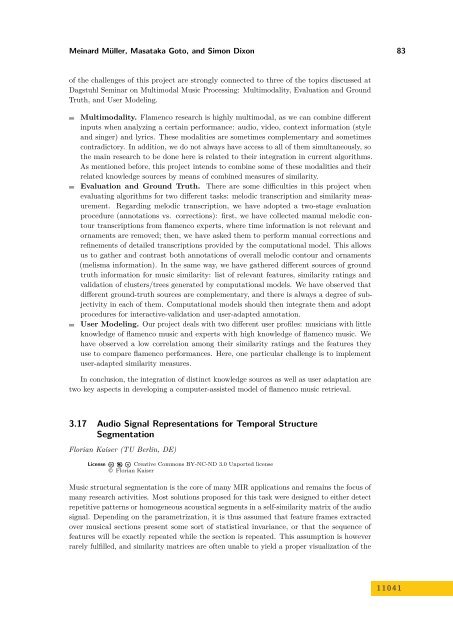Volume 1, Issue 1, January 2011 - DROPS - Schloss Dagstuhl
Volume 1, Issue 1, January 2011 - DROPS - Schloss Dagstuhl
Volume 1, Issue 1, January 2011 - DROPS - Schloss Dagstuhl
You also want an ePaper? Increase the reach of your titles
YUMPU automatically turns print PDFs into web optimized ePapers that Google loves.
Meinard Müller, Masataka Goto, and Simon Dixon 83<br />
of the challenges of this project are strongly connected to three of the topics discussed at<br />
<strong>Dagstuhl</strong> Seminar on Multimodal Music Processing: Multimodality, Evaluation and Ground<br />
Truth, and User Modeling.<br />
Multimodality. Flamenco research is highly multimodal, as we can combine different<br />
inputs when analyzing a certain performance: audio, video, context information (style<br />
and singer) and lyrics. These modalities are sometimes complementary and sometimes<br />
contradictory. In addition, we do not always have access to all of them simultaneously, so<br />
the main research to be done here is related to their integration in current algorithms.<br />
As mentioned before, this project intends to combine some of these modalities and their<br />
related knowledge sources by means of combined measures of similarity.<br />
Evaluation and Ground Truth. There are some difficulties in this project when<br />
evaluating algorithms for two different tasks: melodic transcription and similarity measurement.<br />
Regarding melodic transcription, we have adopted a two-stage evaluation<br />
procedure (annotations vs. corrections): first, we have collected manual melodic contour<br />
transcriptions from flamenco experts, where time information is not relevant and<br />
ornaments are removed; then, we have asked them to perform manual corrections and<br />
refinements of detailed transcriptions provided by the computational model. This allows<br />
us to gather and contrast both annotations of overall melodic contour and ornaments<br />
(melisma information). In the same way, we have gathered different sources of ground<br />
truth information for music similarity: list of relevant features, similarity ratings and<br />
validation of clusters/trees generated by computational models. We have observed that<br />
different ground-truth sources are complementary, and there is always a degree of subjectivity<br />
in each of them. Computational models should then integrate them and adopt<br />
procedures for interactive-validation and user-adapted annotation.<br />
User Modeling. Our project deals with two different user profiles: musicians with little<br />
knowledge of flamenco music and experts with high knowledge of flamenco music. We<br />
have observed a low correlation among their similarity ratings and the features they<br />
use to compare flamenco performances. Here, one particular challenge is to implement<br />
user-adapted similarity measures.<br />
In conclusion, the integration of distinct knowledge sources as well as user adaptation are<br />
two key aspects in developing a computer-assisted model of flamenco music retrieval.<br />
3.17 Audio Signal Representations for Temporal Structure<br />
Segmentation<br />
Florian Kaiser (TU Berlin, DE)<br />
License Creative Commons BY-NC-ND 3.0 Unported license<br />
© Florian Kaiser<br />
Music structural segmentation is the core of many MIR applications and remains the focus of<br />
many research activities. Most solutions proposed for this task were designed to either detect<br />
repetitive patterns or homogeneous acoustical segments in a self-similarity matrix of the audio<br />
signal. Depending on the parametrization, it is thus assumed that feature frames extracted<br />
over musical sections present some sort of statistical invariance, or that the sequence of<br />
features will be exactly repeated while the section is repeated. This assumption is however<br />
rarely fulfilled, and similarity matrices are often unable to yield a proper visualization of the<br />
1 1 0 4 1













